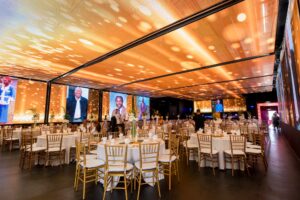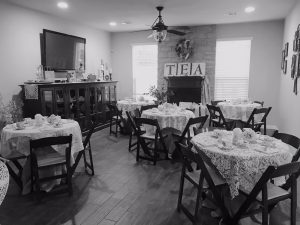So you’re hosting an event with a big attraction… perhaps a keynote speaker, band, or you’re dealing with a formal ceremony. What do all of these events have in common? You’re going to need a stage. Stages come in various sizes, and what you’ll need depends on what kind of event you are holding.
If you’re not sure what size stage you’ll need, you’ve come to the right place! This guide covers what size stage you need based on your event type. We’ll also explain key factors like stage dimensions standards, height options, and how to match the stage to your crowd size and equipment needs.
- How Much Does It Cost to Rent a Stage?
- Stage Sizes Based on Event Type
- Essential Stage Accessories for Events
- Indoor vs Outdoor Stage Considerations
How Much Does It Cost to Rent a Stage?
The cost to rent a stage depends mostly on the size. Smaller stages for single speakers or ceremonies usually start at a few hundred dollars. Larger stages for concerts, big weddings, or outdoor festivals can cost closer to a thousand dollars or more.
Other factors like location, setup complexity, and add-ons like skirting or stairs can also affect the total price.
In the next section, you’ll find a simple table that breaks down typical stage sizes, event types, and average rental costs. It’s a good starting point to estimate what your event might need and what it might cost.
Standard Stage Dimensions Based on Event Type
When considering what size stage to rent, start with the overall size of the venue. Asking the venue coordinator what size stage typically fits is a great first step. Then, consider how large it must be to accommodate the activity that will take up the most space on the stage.
A much smaller 20 square foot stage rental can accommodate a single speaker at a podium, but if you will also have a 12-piece band performing in the final moments of the event, you’ll need to rent a much larger stage, like a 16′ x 28′ rental.
Most stage rentals aren’t one big piece. They’re built out of smaller panels, a lot like a dance floor. That means you’ll need to figure out two things: the total size you want and how many panels it will take to build it.
First, decide how big the stage needs to be. Think about the number of people or equipment that will be on stage at the same time. Then, check what size panels your rental company offers. Most portable stage panels are either 4’ x 4’ or 4’ x 8’.
Common Stage Dimensions & What They Cost to Rent
| Stage Size | Square Feet | Group Size | No. of
4 x 4 Panels |
Avg. Price |
|---|---|---|---|---|
| 8 x 12 | 96 | Single speaker with podium | 6 | $300 |
| 16 x 12 | 192 | Panel of speakers | 12 | $600 |
| 16 x 20 | 320 | 5-8 piece band | 20 | $1,000 |
| 16 x 24 | 384 | 8-10 piece band (rectangle) | 24 | $1,200 |
| 20 x 20 | 400 | 8-10 piece band (square) | 25 | $1,250 |
| 16 x 28 | 448 | 10-12 piece band | 28 | $1,400 |
What Accessories Do You Need for Renting a Stage?
When you rent a stage, you shouldn’t just rent the stage itself. There are a few accessories that you should strongly consider renting for your event, to complete the look of your stage and make it easy to access for your performers.
Stage Stairs with Handrails
Stage stairs with handrails make it easy for speakers, performers, and guests to get on and off the stage safely. Most setups include handrails for extra support, and they’re a must-have for any formal event.
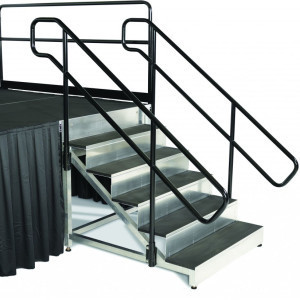
Stage Skirting
Stage skirting covers the gap between the stage and the floor, hiding cords and equipment from view. Traditional black gathered skirting works well for most events, but white spandex skirting is a great choice for a cleaner, modern look.
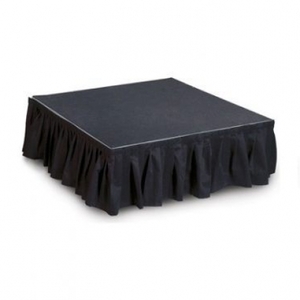
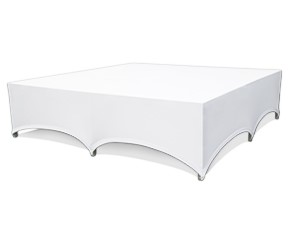
Pipe and Drape Backdrops
Pipe and drape creates a simple, elegant backdrop behind the stage. Most rentals offer black or white options, usually 8′ or 12′ tall. Fabric choices range from budget-friendly banjo cloth to luxurious velour, depending on the style of the event.
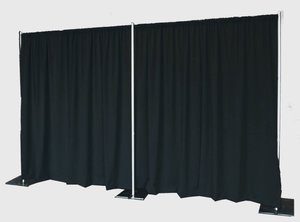

Stage Guardrails
Stage guardrails add extra safety, especially for stages that are more than a few feet tall. Rentals are usually priced per section, with each guardrail measuring around 4 feet wide and 3.5 feet tall.

Indoor vs. Outdoor Stage Rental Considerations
Planning an outdoor event? There are a few extra details to think through when renting a stage outside.
- Outdoor stages often need leveling if the ground isn’t perfectly flat. Even small slopes can make a big difference once a stage is set up. Most rental teams can adjust for uneven ground, but it’s a good idea to walk the space ahead of time and point out any dips or bumps.
- Weather is another big factor. Renting a canopy or covered stage helps protect performers and equipment from rain or strong sun. Some events may also need sidewalls or additional supports depending on the season.
- Wind is a bigger concern for outdoor stages, especially with larger setups. Guardrails, additional anchoring, or even wind-rated stage designs might be recommended based on the forecast and location. Checking with the venue about any outdoor stage rules can help avoid last-minute surprises.
Taking the time to plan for outdoor needs ensures that your stage is safe, secure, and ready for anything the day brings.
Need to Rent a Stage? Let Us Help!
Choosing the right stage size and setup can make a big difference in how an event looks and feels. Whether you need a small platform for a ceremony or a full concert setup for a large crowd, understanding stage dimensions and accessories helps make the rental process simple.
Reventals offers a wide range of stage rentals, along with all the extras like stairs, skirting, and backdrops to complete the look. Our team can help recommend the right size based on your event type, venue, and budget.
If you’re ready to get started, check out our stage rental options here!




